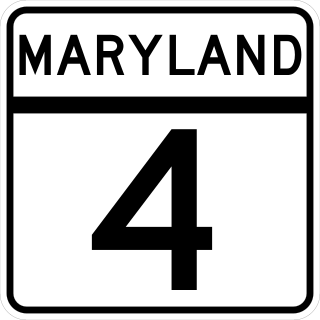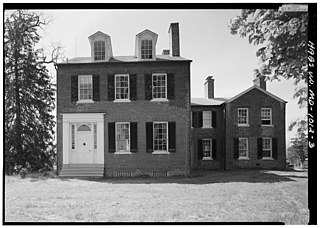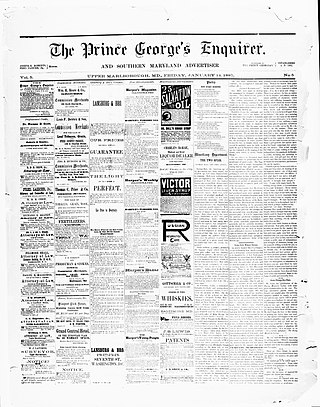Related Research Articles

Prince George's County is located in the U.S. state of Maryland bordering the eastern portion of Washington, D.C. As of the 2020 U.S. census, the population was 967,201, making it the second-most populous county in Maryland, behind neighboring Montgomery County. The 2020 census counted an increase of nearly 104,000 in the previous ten years. Its county seat is Upper Marlboro. It is the largest and the second most affluent African American-majority county in the United States, with five of its communities identified in a 2015 top ten list.

Upper Marlboro, officially the Town of Upper Marlboro, is the seat of Prince George's County, Maryland. As of the 2020 census, the population within the town limits was 652, although Greater Upper Marlboro, which covers a large area outside the town limits, is many times larger.

Benjamin Contee was an American Episcopal priest and statesman from Maryland. He was an officer in the American Revolutionary War, a delegate to the Confederation Congress, and member of the first United States House of Representatives.
Thomas Sim Lee was an American planter, patriot and politician who served as Maryland Governor for five one-year terms, as well as in the Congress of the Confederation (1783-84), Maryland Ratification Convention of 1788 and House of Delegates in 1787. He also held local offices and owned many town lots in Georgetown (which became part of the new federal city, Washington, District of Columbia,and spent his final decades operating "Needwood" plantation in Frederick County, Maryland. In addition to working closely with many of the Founding fathers, he played an important part in the birth of his state and the nation.

Maryland Route 4 is a state highway in the U.S. state of Maryland. The highway runs 64.85 miles (104.37 km) from MD 5 in Leonardtown north to Southern Avenue in Suitland at the District of Columbia boundary, beyond which the highway continues into Washington as Pennsylvania Avenue. MD 4 is a four- to six-lane highway that connects Washington and communities around Interstate 95 (I-95)/I-495 with southern Prince George's County with southwestern Anne Arundel County. The highway is the primary highway for the length of Calvert County, during most of which the route runs concurrently with MD 2. MD 4 also connects Calvert and St. Mary's counties via the Governor Thomas Johnson Bridge across the Patuxent River. The highway connects the Southern Maryland county seats of Leonardtown, Prince Frederick, and Upper Marlboro.
John Rogers was a Founding Father of the United States, who served as a lawyer and judge from Upper Marlboro, Maryland. Rogers was a delegate for Maryland to the Continental Congress in 1775—1776, when he voted for the Declaration of Independence but became ill before he could sign it. Rogers was Maryland's Chancellor, the equivalent of governor, from 1778 until his death 11 years later.

Lansdale Ghiselin Sasscer represented the fifth district of the state of Maryland in the United States House of Representatives for seven terms from 1939 to 1953.

Thomas Fielder Bowie was an American politician who served in office from 1842 to 1859.

Thomas John Claggett was the first bishop of the newly formed American Episcopal Church to be consecrated on American soil and the first bishop of the recently established (1780) Diocese of Maryland.

St. Barnabas Church, also known as St. Barnabas' Episcopal Church, Leeland, was built in Leeland, Maryland, and was established in 1704 as the parish church of Queen Anne Parish which had been established that same year. Because of its location in one of the richest tobacco-producing regions in Colonial Maryland, the small church has been a cultural hub for southern Maryland from early colonial times, through the American Revolution, Civil War, and Reconstruction. The church holds some highly significant art and was the scene of a fiery anti-revolutionary showdown that was close to erupting in violence.

Kingston, or Sasscer's House, is a 1+1⁄2-story historic home located at Upper Marlboro, Prince George's County, Maryland, United States. It is believed to be the oldest building remaining in the town of Upper Marlboro and may have been built, at least in part, before 1730. Many alterations and additions were made to it in the Victorian era, including "gingerbread" details typical of this era. The Craufurd family cemetery is located in the woods northwest of the house.

Pleasant Hills is a historic home located near Upper Marlboro in Prince George's County, Maryland, United States. It is a large, two-part brick house with Greek Revival detailing. The more recent, main block, was built in 1836 by Zaddock Sasscer.
Frederick Douglass High School (FDHS), is an American public high school established in 1935 and located in the Croom census-designated place of unincorporated Prince George's County, Maryland, United States, with a mailing address of Upper Marlboro and near Upper Marlboro.

Brock Hall is an unincorporated area and census-designated place in eastern Prince George's County, Maryland, United States, located south of Largo and Bowie, and north of Upper Marlboro. As of the 2020 census, the CDP had a population of 13,181.
Lansdale Ghiselin Sasscer Jr. was a member of the Maryland House of Delegates, serving from 1955 to 1963.

The Digges-Sasscer house is an historic building in Upper Marlboro, Maryland. It has been home to Lansdale Ghiselin Sasscer, Lansdale Ghiselin Sasscer, Jr. and Daniel Carroll Digges. The house has been documented by the Historic American Buildings Survey and is listed in the Maryland Historical Trust.

The Prince George's Enquirer and Southern Maryland Advertiser was a weekly newspaper published from 1882 to January 30, 1925, in Upper Marlboro, Maryland. It replaced a paper that had been established during the American Civil War by Michael J. Slayman, The Prince Georgian and Southern Maryland Advertiser. The Enquirer was founded by Joseph K. Roberts and Frederick Sasscer, Jr., both politically well-connected lawyers from Upper Marlboro. Roberts died in 1888, but Sasscer continued to edit the paper and eventually became its owner, solidifying the paper's political stance as staunchly Democratic. In 1909, an apprentice working for the paper, Samuel A. Wyvill, became part owner. Together, Sasscer and Wyvill bought the Marlboro Gazette from Mary and Charles Wilson on January 30, 1925, and named the new merged paper The Enquirer-Gazette. Frederick Sasscer remained editor until his death in 1929. The Enquirer-Gazette continues to publish issues to this day.
The Enquirer-Gazette is a weekly newspaper published in Upper Marlboro, Maryland.
Marlboro Colored High School, also known as Upper Marlboro Colored High School, was a segregated public high school for African American students from 1923 until 1935 in Prince George's County, Maryland. It was succeeded by Frederick Douglass High School, which opened in 1935 on a new campus.
References
- 1 2 3 "Frederick Sasscer". The Prince George's Hall of Fame. The Hall of Fame, Prince George's County, Inc. Archived from the original on 5 February 2015. Retrieved 27 January 2013.
- ↑ Valentine, Daniel (11 June 2009). "Former delegate was witness to county's transformation". Prince George's Gazette . Archived from the original on 20 August 2014. Retrieved 27 January 2013.
- 1 2 Doliante, Sharon J. (1998). Maryland and Virginia Colonials. Clearfield Co. p. 927. ISBN 978-0806312934.
- ↑ "About The Prince George's enquirer and southern Maryland advertiser". Chronicling America. Library of Congress. Retrieved 5 March 2018.
- ↑ "About The enquirer-gazette". Chronicling America. Library of Congress. Retrieved 5 March 2018.